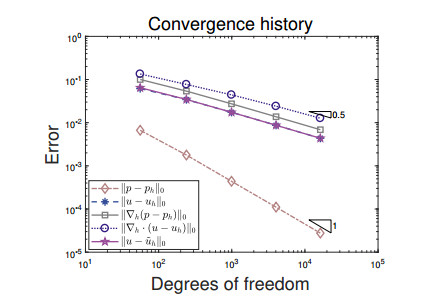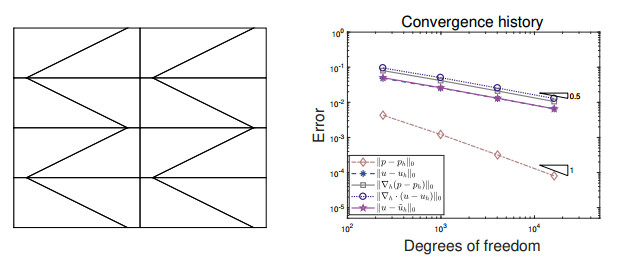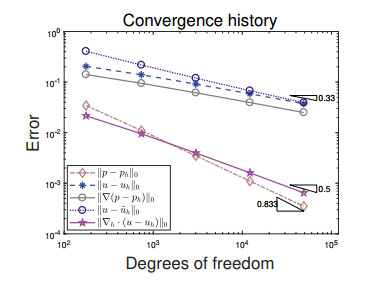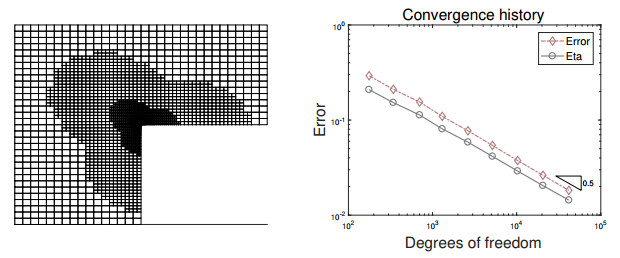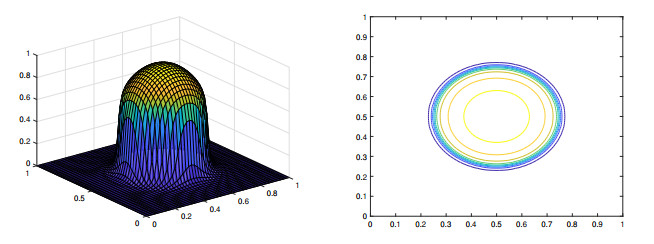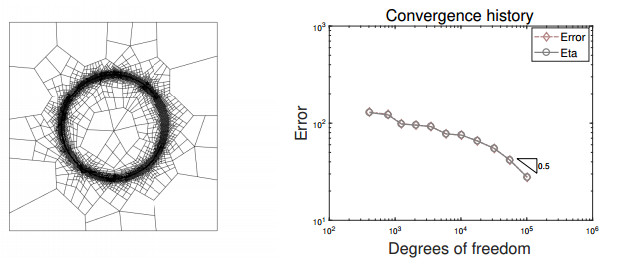1.
Introduction
Staggered discontinuous Galerkin (SDG) methods on triangular meshes have been actively studied since the pioneering works of Chung and Engquist [20,21]. SDG methods earn many desirable features, such as local and global conservations, superconvergence and preservation of physical laws. Recently, a lowest order SDG method on general meshes has been developed for Poisson equation [31,39], the Stokes equations [40], linear elasticity equations [43], respectively. The key idea of the lowest order SDG method on general meshes is to divide the initial partition into the union of triangles by connecting the interior point to the vertices of the initial partition. Then two finite element spaces are defined on the resulting triangulations, and the continuity of them are staggered on the interelement boundaries. The construction of the SDG method on triangular meshes and on polygonal meshes shares some similarities, while the lowest order SDG method on polygonal meshes is more competitive for practical applications. The lowest order SDG method enfolds the following features: First, it allows arbitrary shapes of polygons. Second, it can be flexibly applied to rough grids. Third, hanging nodes are allowed, which can be simply treated as additional vertices. Very recently, arbitrarily high order SDG methods have been developed for various problems of interest [30,41,42,44].
Although SDG methods earn many desirable features, one of the disadvantages is that the inf-sup condition is needed to establish the stability, which is usually not an easy task. Least squares method is considered as an alternative to the saddle point formulations and can circumvent the inf-sup condition. Examples of application of least squares to scalar elliptic equations, Helmholtz equation, linear elasticity, the Stokes equations and the Navier-Stokes equations can be found in [6,7,13,14,19]. The purpose of this paper is to develop a first-order staggered least squares method for Poisson equation on polygonal meshes. Different from the standard SDG methods, our method employs the locally conforming Raviart-Thomas (RT) element and locally conforming linear element as the function spaces. And the construction of locally conforming RT elements is much simpler than the flux space employed in the standard SDG methods. Since continuity of the function spaces are staggered on the interelement boundaries, we impose the flux jump term and potential jump term to stabilize the least squares functional. The resulting staggered least squares method inherits the aforementioned features of the lowest order SDG method. Stability and optimal a priori error estimates in energy norm are developed. It is worth mentioning that in the first-order least squares method, the built-in functional provides a natural error estimator. One can refer to [22,38] for related works on guaranteed a posteriori error estimators for the SDG method and to [11,17,18,29,32,34] for a posteriori error estimators for the least squares method.
Superconvergence of finite element methods has drawn great attention for a few decades. It has strong relevance to a posteriori error estimation. Most of the existing works are devoted to superconvergence on rectangular meshes, among these, we cite in particular the works [26,27,35]. Superconvergence on triangular meshes can be referred to [3,9,33,37]. Superconvergent estimates for RT elements on triangular meshes are not an easy task, and the variational error expansion for RT elements on a local triangle in terms of the normal trace (cf. [33]) is the key ingredient. Our superconvergent estimate in energy norm is motivated by the work given in [33], while some new techniques are also exploited due to the different expressions of least squares functional. One of the major differences is Eq (3.9), which can not be bounded by direct application of Lemma 3.4. To overcome this issue, we introduce piecewise constant projections and employ the equivalence between the energy norm and divergence norm of RT elements.
Another new contribution is to study the L2 norm error estimates via a duality argument. It is straightforward for the standard SDG method, while it is less obvious for the staggered least squares method. Our staggered least squares method is nonconforming in the sense that the function spaces are partially continuous over the interelement boundaries. If we proceed as in [12], then the L2 norm of the potential will be expressed in terms of the bilinear form and the edge integration for the potential error and flux error (see Lemma 3.6). The standard trace theorem will lead to the loss of the optimal convergence rates for L2 error. To overcome this issue and achieve the optimal convergence rates in L2 error, the superconvergent estimates measured in energy norm as well as the standard trace theorems are exploited.
On the other hand, local and global conservations are attractive properties in practical applications, while standard least squares method can not preserve the conservation properties. The staggered least squares method also fails to preserve the local and global conservations. Therefore, we attempt to develop a postprocessing scheme which can ensure local and global conservations. The postprocessing scheme developed in this paper takes advantage of the single valued flux over the outer boundary of the dual partition, which can be corrected by using some simple local procedure, yielding locally conservative flux over the dual partition. Then the locally conservative flux over the resulting triangulations can be constructed by using direct calculations. We remark that the postprocessing scheme developed in this paper mimics the one proposed in [8], where quadrilateral elements are considered. We modify the scheme proposed therein to fit it into polygonal meshes.
The rest of the paper is organized as follows. In the next section, we introduce the staggered least squares method and present some preliminary results. Then in Section 3, some error estimates, superconvergent estimates and L2 norm error estimate are proposed. In Section 4, a postprocessing scheme for flux is established, which ensures the local and global conservations. Several numerical experiments are carried out in Section 5 to confirm the theoretical findings. Finally, a conclusion is given at the end of the paper.
2.
Least squares method on staggered mesh
Let Ω be a bounded domain in R2 with Lipschitz continuous boundary ∂Ω. We consider the Dirichlet boundary value problem
By introducing a new variable u=−∇p, the original problem can be recast into the first order system:
Next, we introduce some notations that will be used throughout the paper. Let D⊂Rd,d=1,2, we adopt the standard notations for the Sobolev spaces Hs(D) and their associated norms ‖⋅‖s,D, and semi-norms |⋅|s,D for s≥0. The space H0(D) coincides with L2(D), for which the norm and inner products are denoted as ‖⋅‖D and (⋅,⋅)D, respectively. If D=Ω, the subscript Ω will be dropped unless otherwise mentioned. In the sequel, we use C to denote a generic positive constant which may have different values at different occurrences.
Now we can define our staggered least squares method. We start by introducing the meshes employed in our construction, which is also one of the key ingredients. Following [21,39], three meshes will be constructed: the primal mesh Tprm, the dual mesh Tdl and the primal simplicial submeshes Th. We first let Tprm be the initial (primal) partition of the domain Ω into non-overlapping simple quadrilateral/polygonal elements. We let Fprm be the set of all primal edges in this partition and F0prm be the subset of all interior edges, that is, the set of edges in Fprm that do not lie on ∂Ω. For each quadrilateral/polygon E in the initial partition Tprm, we select an interior point ν and create new edges by connecting ν to the vertices of quadrilateral/polygon, and the set collecting all the interior point is denoted as N1. This process will divide E into the union of triangles, where the triangle is denoted as τ, and we rename the union of these triangles by S(ν). We remark that S(ν) are the quadrilaterals/polygons in the initial partition (primal mesh). Moreover, we will use Fdl to denote the set of all the dual edges generated by this subdivision process and use Th to denote the resulting triangulations, on which our basis functions are defined. For each triangle τ∈Th, we let hτ be the diameter of τ and h=max{hτ,τ∈Th}. Furthermore, Th is assumed to satisfy the local quasi-uniform assumption in the sense that for any pair of elements τ and τ′ in Th which share an edge, there exists a constant κ independent of hτ and hτ′ such that κ−1≤hτ/hτ′≤κ. In addition, we define F:=Fprm∪Fdl and F0:=F0prm∪Fdl. This construction is illustrated in Figure 1, where solid lines are edges in Fprm and dotted lines are edges in Fdl.
For each interior edge e∈F0prm, we use D(e) to denote the union of the two triangles in Th sharing the edge e (dual mesh), and for each boundary edge e∈Fprm∖F0prm, we use D(e) to denote the triangle in Th having the edge e, see Figure 1. We write Tdl as the union of all D(e). In addition, we define Tintdl as the set collecting D(e) for all interior edges e∈F0prm and Textdl as the set collecting D(e) for all boundary edges e∈Fprm∖F0prm. In the sequel, we use ∇h and ∇h⋅ to denote element-wise defined gradient and divergence operators with respect to Th respectively.
For each edge e, we define a unit normal vector ne as follows: If e∈F∖F0, then ne is the unit normal vector of e pointing towards the outside of Ω. If e∈F0, an interior edge, we then fix ne as one of the two possible unit normal vectors on e. When there is no ambiguity, we use n instead of ne to simplify the notation.
The following mesh regularity assumptions are also needed throughout the paper (cf. [5,15]).
Assumption 2.1. We assume there exists a constant ρ>0 such that
(1) For every element S(ν)∈Tprm and every edge e∈∂S(ν), it satisfies he≥ρhS(ν), where he denotes the length of edge e and hS(ν) denotes the diameter of S(ν).
(2) Every element S(ν) in Tprm is star-shaped with respect to a ball of radius ≥ρhS(ν).
We remark that the above assumptions ensure that the triangulation Th is shape-regular.
Let k≥0 be the order of approximation. For every τ∈Th and e∈F, we define Pk(τ) and Pk(e) as the spaces of polynomials of degree less than or equal to k on τ and e, respectively. For w and v belonging to broken Sobolev space, the jump [v] and the jump [v⋅n] are defined respectively as
where vi=v∣τi, vi=v∣τi and τ1, τ2 are the two triangles in Th having the edge e∈F. In the above definitions, we assume n is pointing from τ1 to τ2.
In addition, we let Hr(div;D) be the Banach space
which can be denoted as H(div;D) when r=2.
Finally, we introduce the finite dimensional spaces earning staggered continuity for defining our scheme. We first define the following locally H1(Ω) conforming space Sh:
Here, for w∈Sh, we have w|D(e)∈H1(D(e))∀D(e)∈Tdl,∀e∈Fprm. We next define the following locally H(div;Ω)−conforming SDG space Vh:
where R0(τ)=P0(τ)2⊕(x,y)TP0(τ). Note that if v∈Vh, then v∣S(ν)∈H(div;S(ν)) for each ν∈N1.
Based on the above preparations, we define a least squares functional for (v,q)∈Vh×Sh
The finite element discretization of our staggered least squares corresponding to the L2 norm least squares functional is to minimize functional (2.3) over Sh×Vh such that
Then, (2.4) can be equivalently written as follows: Find (uh,ph)∈Vh×Sh such that
where
We mention the existing methods supporting polygonal meshes with arbitrary polynomial orders such as DG [1,4,16,24], HHO [25], VEM [5], and WG [36]. Advantages of our formulation are as follows. First, the current least squares formulation does not require any stabilization parameters as opposed to the existing polygonal methods. Second, the least square functional itself provides an a posteriori error estimator for adaptive mesh refinements [17,18].
For later analysis, we define
The following discrete Poincaré inequality will be used for the subsequent analysis (cf. [10])
Lemma 2.1. There exists a positive constant C such that for all (v,q)∈Vh×Sh one has
Proof. Integration by parts leads to
and
The Cauchy-Schwarz inequality and norm equivalence imply
The preceding arguments and the discrete Poincaré inequality (2.6) lead to
Therefore
It is trivial that
Thus, the proof is complete by combining the above estimates. □
Theorem 2.1 (Existence and uniqueness). There exists a unique solution to (2.5).
Proof. Since (2.5) is equivalent to a square linear system, existence follows from uniqueness, it suffices to prove the uniqueness. Let f=0 in (2.5) and then (uh,ph) satisfies
By letting v=uh and q=ph in the above equation, we can obtain uh=0 and ph=0 (cf. Lemma 2.1). This completes the proof. □
3.
Error analysis
3.1. Energy error estimates
This section presents the convergence estimates for both potential and flux. To begin, we define the projection operator such that it satisfies
The following approximation properties hold (cf. [21,23])
A projection operator, denoted by Πh, is defined as a linear mapping from Hr(div;Ω) to Vh for some r>2 such that on each element τ∈Th
It satisfies
In addition, we remark that Πhv∈H(div;Ω).
For v∈H1(τ)2,∀τ∈Th, the local Crouzeix-Raviart interpolant ICRhv on τ is the unique element in P1(τ)2 such that
Standard approximation theory yields (cf. [23])
and
In addition, they satisfy (cf. [33])
Lemma 3.1. ΠhICRhv=Πhv.
Theorem 3.1. Assume that (u,p) is in H1(Ω)2×H2(Ω) and that the divergence of the flux ∇⋅u is in H1(Ω). Let (uh,ph) denote the numerical solution of (2.5). Then, we have
Proof. Replacing (uh,ph) by (u,p) in (2.5), we can obtain
It then yields the following error equation
which gives
Lemma 2.1 and the definition of the bilinear form A lead to
We have from (3.2)
Standard approximation theory yields
Trace inequality and standard approximation theory (3.1) imply
Finally, we have from the definition of Πh
The preceding arguments, the triangle inequality and the interpolation error estimates (cf. (3.3)–(3.5)) yield the desired estimate. □
Theorem 3.2. Let (u,p) satisfy the assumption of Theorem 3.1 and let (uh,ph) be the numerical solution of (2.5). Then, we have
Proof. Given ϕ∈H1(Ω), let α solve −Δα=ϕ in Ω, α=0 on ∂Ω, and let β=−∇α, so ∇⋅β=ϕ. Then ‖α‖2≤C‖ϕ‖1, ‖∇⋅β‖1≤C‖ϕ‖1. We have from the definition of the dual norm
Thus,
which together with (3.7) yields the desired estimate. □
3.2. Superconvergence and L2 error estimate
In this section, we aim to derive the superconvergent estimates. Most of the existing literatures are devoted to the rectangular cases. The function spaces exploited in our method is essentially defined on the triangular meshes, which makes it more complicated to derive the superconvergent estimate. To this end, we employ the variational error expansions for RT elements on a local triangle in terms of the normal trace.
The next two lemmas are given in [33].
Lemma 3.2. For vL∈P1(τ)2,
where
and {ek}3k=1 denote the edges of triangle τ∈Th, {nk}3k=1 the unit outward normal vectors, {tk}3k=1 the unit tangent vectors with counterclockwise orientation, and {λk}3k=1 are barycentric coordinate functions. In addition, k±1 permuted cyclically.
Lemma 3.3. For vh∈P0(τ)2 and vL∈P1(τ)2
where
and A(j)k are operators defined by
Now we are ready to prove the next lemma, which is crucial in the proof of the superconvergence.
Lemma 3.4. For vh∈P0(Th)2, the following estimate holds
Proof. Lemmas 3.1 and 3.3 imply
Standard interpolation theory (3.5) yields
The elementary identity
leads to
The Cauchy-Schwarz inequality and trace inequality yield
□
Let Qh denote the standard linear interpolation operator, and we find the following lemma useful for the subsequent analysis (cf. [28]).
Lemma 3.5. For any quadratic function pQ, we have
Let Π0 denote the L2 orthogonal projection onto the piecewise constants P0(Th)2, and it satisfies
The superconvergent estimate can be stated in the next theorem.
Theorem 3.3. (superconvergence) Let (uh,ph) be the numerical solution of (2.5). Then, we have
Proof. We can infer from Lemma 2.1
It follows from (3.2)
Any function vh∈Vh can be expressed in the following form on each triangle τ∈Th:
We have
Then, Lemma 3.4 and (3.8) yield
and
Integration by parts implies
Without loss of generality, we assume that p∈P2, then the first term of (3.10) can be bounded by Lemma 3.5
Standard interpolation theory and the Cauchy-Schwarz inequality yield the upper bound for the second term of (3.10)
Assume that p∈P2, then we have from Lemma 3.5 and integration by parts
The proof is complete by combining the preceding arguments. □
Lemma 3.6. Let (u,p) be the solution of (2.2) and (uh,ph) be the numerical solution of (2.5). Then there exists (γ,w) and z such that
and that
Proof. Let z∈H10(Ω) be the solution of the following problem
We assume that the following regularity estimate holds
Multiplying both sides of (3.12) by p−ph, adding and subtracting (u−uh,∇z), and integration by parts imply
It suffices to find (γ,w)∈Hr(div;Ω)×H10(Ω),r>2 such that
and that
To do so, let w∈H10(Ω) be the solution of the scalar elliptic problem (2.1) with the right hand side f=z−Δz. The regularity estimate (3.13) and the triangle inequality imply
Let γ=∇(z−w). It is then easy to check that (γ,w) satisfies (3.14). Now (3.15) follows from (3.13), (3.16), and the facts that
and that
The proof is complete by combining the preceding arguments. □
Now we are ready to prove the L2 norm error estimate, which is also the main result of this section.
Theorem 3.4. Let (u,p) be the solution of (2.2) and (uh,ph) be the numerical solution of (2.5). Then, we have
Proof. We have from (3.6), (3.11), the Cauchy-Schwarz inequality and standard interpolation theory
On the other hand, we have from the definition of dual norm, trace theorem and the discrete Poincaré inequality (2.6) that
where ‖⋅‖Σ,τ denotes ‖⋅‖Σ restricted to each element τ∈Th.
Proceeding analogously, we have
The assertion follows by combining the preceding arguments, Theorems 3.1, 3.3 and Lemma 3.6. □
Remark 3.1. The L2 norm error estimate for potential given in Theorem 3.4 is constructed by exploiting duality argument and superconvergent estimate (cf. Theorem 3.3). The optimal convergence estimate in L2 norm proposed above requires higher regularity than the one given in [12], which is due to the superconvergent estimate.
4.
Locally conservative flux correction
In this section, we aim to formulate a simple, local procedure that replaces uh by a field ˜uh∈H(div;Ω) and satisfy
The construction proposed in this section can be flexibly applied to general meshes. There are two steps involved in our postprocessing scheme: first, inspired by the work given in [8], we construct a function which satisfies
where n denotes the unit outward normal vector of D(e); then, we can construct a function ˜uh∈H(div;Ω) satisfying
To complete the first step, we proceed as follows. Let D(e) denote an arbitrary dual mesh belonging to Tintdl. Let ei,i=1,…,4 denote the (oriented) edges lying on ∂D(e), let ϕei,i=1,…,4 denote the flux of uh across the edge ei and let n denote the unit outward normal vector of ∂D(e). In addition, σi=1 if orientation of ei coincides with the outer normal on ∂D(ei) and σi=−1 otherwise. A function uh∈Vh satisfies
which immediately leads to
where hei,i=1,…,4 denotes the length of the respective edges.
We seek to define modified flux values ˜ϕei=ϕei−σiδϕei and a function ˜uh which satisfies
such that
To define the corrected flux values for an element D(e), we proceed as follows. If, for a given edge ei, the flux ϕei has already been corrected, we set δϕei=0. If the flux on ei has not yet been corrected, we set
where nD(e)>0 is the summation of the length of all the edges on ∂D(e) whose fluxes have not been corrected.
Consider now a dual partition Tintdl of Ω with nh interior dual elements. To define the flux-correction algorithm, some additional notation is necessary. Let
denote the set of all edges in the union of the dual elements indexed by i1,⋯,ik. For example, e(il)=∂Dil is the set of all outer edges of element Dil∈Tintdl. Define
Given uh∈Vh, the following algorithm finds ˜uh that is locally conservative over each D(e)∈Tdl:
(1) Define a permutation π={i1,i2,…,inel} of all elements in Tintdl such that
(2) For k=1,…,nh, apply the element flux correction procedure to element Dik.
We remark that the above procedure constructs a function ˜uh satisfying
for D(e)∈Tintdl. For elements D(e) in Textdl, if the flux value over ∂D(e)∖∂Ω has not been corrected, then we set the flux value to be equal to the flux value of uh over that edge. At this point, we have determined the flux values of ˜uh over all the edges belonging to Fdl. To calculate the flux values over the edges belonging to Fprm, we number the edges of an arbitrary element τ∈Th as ei,i=1,…,3 and e1 denotes the edge that belongs to Fprm. The flux values over e2 and e3 have already been corrected, which we denote as ˜ϕ2 and ˜ϕ3, respectively. We can define the flux value over e1 by
Then, ˜uh in each element can be represented as
where Wei is the RT shape function associated with edge ei. The above procedure yields a function ˜uh∈H(div;Ω) and satisfies the local conservation.
Remark 4.1. Our locally conservative flux correction is motivated by the work given in [8], while some modifications are made. First, different from the work in [8], our locally conservative flux correction is essentially defined on triangular meshes, which makes it well suited to general meshes. Second, our construction is based on locally conforming H(div;Ω) elements, thus, locally conservative flux on dual partitions are considered first and then locally conservative flux on each triangle can be constructed by applying some simple local procedure.
5.
Numerical experiments
In this section, we present several numerical examples to test the performance of the proposed method. The convergence history for various errors under uniform refinement are displayed. In addition, some numerical experiments are carried out to test the performance of the adaptive mesh refinement guided by the least squares functional estimator. Moreover, the adaptive mesh refinement can be pursued by connecting the midpoint of each planar face of its boundary to the barycenter of the element, and more details regarding the adaptive mesh refinement strategies can be found in [39]. By refining in this fashion, hanging nodes may be introduced, which can be simply treated as new nodes since adjacent co-planar elemental interfaces are perfectly acceptable for our method.
Example 5.1 (Smooth solution on unit square domain). In this example, we consider Ω=(0,1)2, and the exact solution is given by p=x(1−x)y(1−y), where the right hand side f can be calculated correspondingly.
We first partition the domain Ω into uniform square grids. Note that the mesh size h≈N−1/2, where N represents the number of degrees of freedom. The convergence history for various errors against the number of degrees of freedom are displayed in Figure 2, where optimal convergence rates can be achieved. In addition, we can observe from the numerical tests that the postprocessed flux has first order convergence and the L2 accuracy is not influenced. Then, we partition the domain Ω into trapezoidal grids of base h in vertical direction and parallel horizontal edges of size 0.2h and 1.8h, as proposed in [2,39] and shown in Figure 3. We can observe from the numerical results that optimal convergence rates can be obtained. Next, we test the performance of the proposed method by using Voronoi mesh as shown in Figure 4, again, optimal convergence rates can be achieved. The numerical results in Table 1 indicate that the postprocessed flux can recover local and global conservations for rough grids. Here, Dofs denotes the number of degrees of freedom.
Let
then we have:
Example 5.2 (Classical L-shaped domain). In this example, we consider the L-shaped domain
The exact solution in polar coordinates is given by
The convergence history under uniform refinement are reported in Figure 5. As expected, reduced convergence rates are achieved, which is due to the reduced regularity. In addition, as shown in Table 2, the postprocessed flux ensures local and global conservations.
To restore the optimal convergence rates, we aim to exploit the adaptive mesh refinement guided by least squares functional estimator which is defined by
and the error is defined as
Indeed, it follows from (2.3) and (2.2) that E(p−ph,u−uh)≈η2. Interested readers can also refer to [17] for the discussions on the equivalence of the error estimator and the error in the least-square methods. The adaptive mesh pattern and convergence history under adaptive mesh refinement are reported in Figure 6, where the singularity is well-captured and optimal convergence rates can be recovered by using adaptive mesh refinement.
Example 5.3 (Solution with circular inner layer). In this example, we set Ω=(0,1)2 and the exact solution is given by
and f can be calculated correspondingly. The solution possesses a circular inner layer where its gradient behaves like O(ϵ−1/2). In our numerical simulation, we set ϵ=10−4.
The plots of the exact solution are shown in Figure 7. The adaptive mesh pattern and convergence history are reported in Figure 8, and we can observe from the numerical results that the circular inner layer can be well captured and optimal convergence rates can be restored.
6.
Conclusions
In this paper, we have developed a staggered least squares method for elliptic equations on general meshes. Optimal a priori error estimates in energy norm and L2 norm are derived. A postprocessing scheme is introduced to ensure local and global conservations on general meshes. The numerical results indicate that the proposed method can be flexibly applied to rough grids, and the postprocessed flux earns local and global conservations on general meshes. In addition, the adaptive mesh refinement guided by the least squares functional estimator is efficient in dealing with problems with singularities. Finally, we remark that the RT element exploited in this paper can also be replaced by BDM1 element, then optimal convergence rates in energy norm can be proved similarly. Our (undisplayed) numerical tests indicate that optimal convergence rates in L2 norm can be obtained for BDM1 element, while the proof for it remains open.
Use of AI tools declaration
The authors declare they have not used Artificial Intelligence (AI) tools in the creation of this article.
Acknowledgments
The research of the the first author was supported by the Research Grants Council of the Hong Kong Special Administrative Region, China [Project No. CityU 21309522]. The research of the second author was supported by the National Research Foundation of Korea (NRF) grant funded by the Ministry of Science and ICT (NRF-2022R1A2B5B02002481).
Conflict of interest
The authors declare no conflicts of interest.
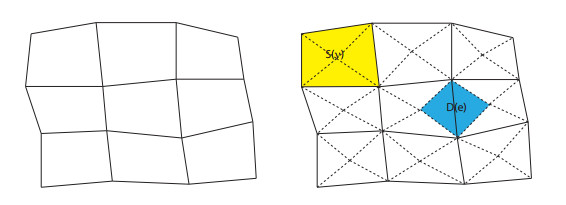









 DownLoad:
DownLoad:
